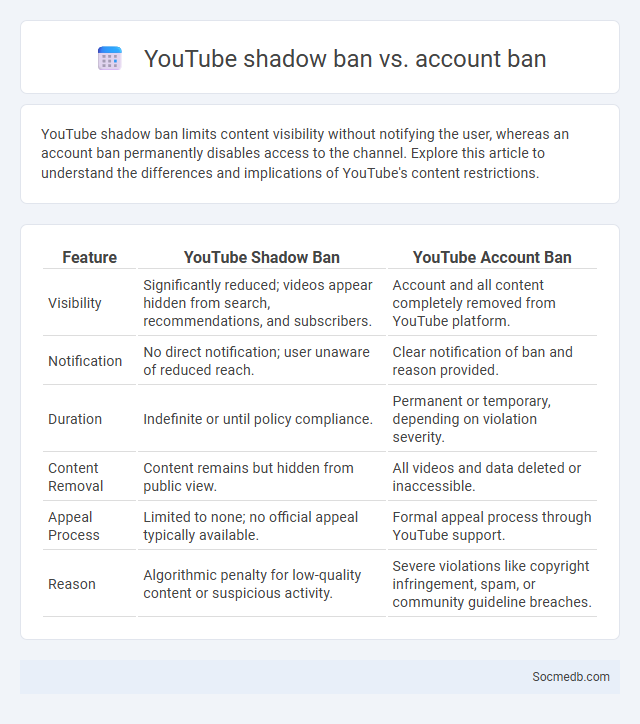
Photo illustration: YouTube shadow ban vs account ban
YouTube shadow ban limits content visibility without notifying the user, whereas an account ban permanently disables access to the channel. Explore this article to understand the differences and implications of YouTube's content restrictions.
Table of Comparison
| Feature | YouTube Shadow Ban | YouTube Account Ban |
|---|---|---|
| Visibility | Significantly reduced; videos appear hidden from search, recommendations, and subscribers. | Account and all content completely removed from YouTube platform. |
| Notification | No direct notification; user unaware of reduced reach. | Clear notification of ban and reason provided. |
| Duration | Indefinite or until policy compliance. | Permanent or temporary, depending on violation severity. |
| Content Removal | Content remains but hidden from public view. | All videos and data deleted or inaccessible. |
| Appeal Process | Limited to none; no official appeal typically available. | Formal appeal process through YouTube support. |
| Reason | Algorithmic penalty for low-quality content or suspicious activity. | Severe violations like copyright infringement, spam, or community guideline breaches. |
Understanding YouTube Shadow Ban
Understanding YouTube shadow ban requires recognizing when your videos or comments have reduced visibility without explicit notification from the platform. This restriction often results from repeated policy violations or algorithmic detection of content deemed harmful or spammy. To protect your content and maintain engagement, monitor your channel analytics closely and adhere strictly to YouTube's community guidelines to avoid triggering shadow bans.
What is a YouTube Account Ban?
A YouTube account ban occurs when YouTube restricts or permanently disables a user's account due to violations of community guidelines, copyright infringement, or repeated policy breaches. This action removes access to all uploaded content, live streams, comments, and monetization features associated with the account. Users can appeal the ban if they believe it was issued in error, but final decisions rest with YouTube's enforcement team.
Shadow Banning: Definition and Mechanics
Shadow banning on social media involves restricting a user's content visibility without their knowledge, causing posts to appear less frequently or disappear from feeds and search results. Algorithms and platform policies detect behavior that violates community standards or triggers spam filters, resulting in reduced engagement and reach. Understanding shadow banning helps you adapt your social media strategy to maintain authentic interaction and avoid content suppression.
Key Differences: Shadow Ban vs Account Ban
Shadow ban limits content visibility without user notification, reducing reach on platforms like Instagram or Twitter, whereas account ban results in full account suspension and access restriction. Shadow bans are subtle, often due to algorithmic flags for spam or policy violations, while account bans follow severe breaches like hate speech or repeated offenses. Understanding these distinctions helps users navigate social media rules and maintain digital presence effectively.
Common Reasons for YouTube Shadow Bans
YouTube shadow bans often occur due to violations of community guidelines, such as posting content with inappropriate language, hate speech, or misinformation. YouTube's algorithm may also restrict your videos if they trigger spam detection systems or if your channel receives multiple user reports. Understanding these common reasons helps you adjust your content strategy to avoid reduced visibility and maintain audience engagement.
Signs Your Channel is Shadow Banned
A sudden drop in video views and engagement rates without server or algorithm updates often indicates a shadow ban on social media channels. Inability of followers to find your content through hashtags or search results further confirms shadow banning. Monitoring analytics for unusual traffic declines and reduced visibility can help identify and address shadow ban issues promptly.
Causes of Permanent Account Bans on YouTube
YouTube permanently bans accounts primarily for repeated violations of community guidelines, including hate speech, harassment, and the dissemination of harmful or misleading content. Copyright infringement, especially through unauthorized use of protected material, is another major cause of account termination. Severe breaches such as inciting violence or promoting dangerous activities also trigger immediate permanent bans to maintain platform safety.
How Shadow Banning Impacts YouTube Creators
Shadow banning significantly reduces a YouTube creator's video visibility by limiting their content from appearing in search results, recommendations, and subscriber feeds without notification. This covert suppression results in decreased engagement, lower ad revenue, and frustrating drops in subscriber growth, hindering channel development. Understanding shadow banning's impact enables you to adjust content strategies to maintain audience reach and platform compliance.
Preventing Both Shadow Bans and Account Bans
To prevent both shadow bans and account bans on social media platforms like Instagram, Twitter, and TikTok, users should consistently follow community guidelines and avoid using banned hashtags or engaging in spammy behavior. Employing authentic engagement techniques, such as interacting genuinely with followers and posting original content, reduces the risk of algorithmic penalties. Monitoring account analytics and staying updated on platform policy changes further helps maintain visibility and account health.
Recovering from a YouTube Ban or Shadow Ban
Recovering from a YouTube ban or shadow ban requires understanding the platform's community guidelines and content policies to identify violations. Creators should appeal the ban through YouTube's official support channels and revise their content strategy to comply with algorithmic standards. Engaging authentically with the audience while avoiding prohibited practices helps restore channel visibility and rebuild subscriber trust.
 socmedb.com
socmedb.com